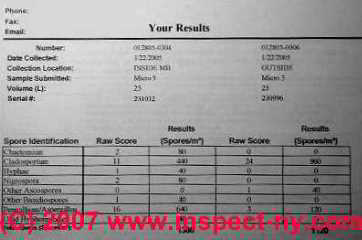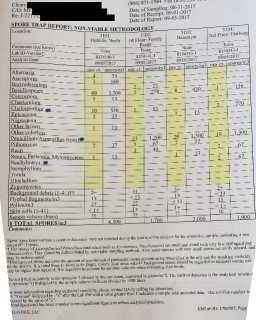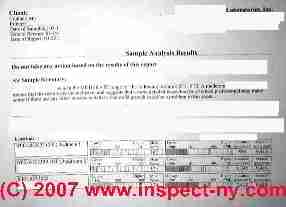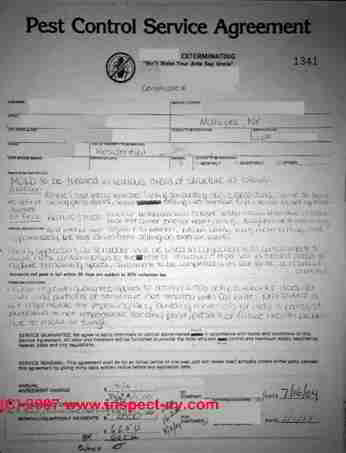 Mold Investigation and Mold Test Lab Reports: What A Valid, Useful Mold Investigation Report Should Include
Mold Investigation and Mold Test Lab Reports: What A Valid, Useful Mold Investigation Report Should Include
- POST a QUESTION or COMMENT about mold test & inspection reports: what should the report contain & how can the report be interpreted?
Guide to mold test & investigation reports:
This article provides a sample site inspection and mold test report, explains what to look for in a valid and useful mold report, describes invalid and not-very useful mold reports to avoid, and helps you interpret your mold lab report.
InspectAPedia tolerates no conflicts of interest. We have no relationship with advertisers, products, or services discussed at this website.
- Daniel Friedman, Publisher/Editor/Author - See WHO ARE WE?
Are Mold Tests Useful Without an actual Building Investigation?
 A professional site investigation for mold, allergens, or other bioaerosols
or indoor air problems and a mold test lab report can produce a lot of
information. In fact it could sound overwhelming.
A professional site investigation for mold, allergens, or other bioaerosols
or indoor air problems and a mold test lab report can produce a lot of
information. In fact it could sound overwhelming.
The mold investigation or mold test report must allow us to answer some key questions (listed below). If it doesn't the cost of the mold test or mold inspection may be close to having been wasted.
At left: an example of a airborne mold investigation "air test" report that left the client with questions .[Click to enlarge any image]
A competent report should identify, right up front, what is important and what needs to be done. It should support these opinions with competent detail and professional, reliable lab work.
Still we are constantly being asked "What does my mold report mean? Do these numbers indicate a mold problem?"
Quality building investigation reports also include professional photo documentation of the investigator's observations at the inspection site as well as microscopic findings in the mold test laboratory.
Clients of mold inspectors should be very welcome to call to discuss the investigator's findings and to ask for a reasonable amount of further explanation or guidance without incurring additional cost. For a discussion of valid and not very valid mold test lab reports for mold exposure, also seeMOLD LAB REPORTS
If you see a large area of mold in a building a simple lab test can confirm that it is or is not a harmful (versus cosmetic) mold. And a carefully-collected sample of settled dust or other types of mold screening samples have some use in a rough building screen for evidence of hidden problematic mold.
But a "bare bones" mold-lab report which simply offers some counts or numbers or culture results, when provided by an investigator who was supposed to have performed a "screening inspection" for mold, but who did not also perform a thorough visual inspection of the building is not a good value.
A superficial mold test risks leaving the client with ambiguous results, or even if the test suggests that a problem mold is present, the client has no idea where the problem is, if any, and what to do about it. If you suspect that there is an indoor air problem in the building involving mold or allergens, you need to know the following:
- Is there a mold, allergen, or similar environmental problem in the building?
- If there is a problem, where is it and how big is it?
- What does the lab work indicate about the level of risk to occupants or workers? Are we looking at a "cosmetic-only" concern?
- What is the extent of demolition or cleaning needed, and based on the lab results, what is the level of containment and care needed?
- What needs to be changed or repaired on the building so that problems don't recur?
- And after the cleanup has been completed, was it proper and complete?
The mold report must be useful: In other words, in exchange for being paid a substantial professional fee to investigate a building, a mold investigator should provide accurate and useful diagnostic and prescriptive information to his or her client, and should include not only an identification of problematic mold, but an indication of where the problem is, how big it is, and what work is needed to remove it - a mold remediation plan.
An ethical mold or environmental investigator should interview the client carefully before the inspection to assist in deciding if such a costly inspection and test process is really appropriate and cost-justified. In cases where there are not occupants at special risk of mold-related illness or respiratory illness, and where there is no building leak history, and where no substantial mold is visible nor suspected, a costly mold investigation may not be appropriate.
MOLD ACTION GUIDE guides you through a series of steps to deal with mold, including the decision of when expert inspection and testing are needed.
We get a lot of calls from people asking us to help them interpret their "mold inspection report."
What we often learn is that there was no actual mold inspection. The "inspector" simply collected some test samples, sent them to a mold test lab, and returned the mold lab test report to the client with no supporting explanation or interpretation. That sort of "mold inspection" is not very helpful as no one can really interpret what the report means.
Adding difficulty to interpreting a mold lab test report is the usual practice by the mold test "expert" of omitting any description of the mold test conditions. Was testing passive - did the inspector tiptoe into a room and collect a tape or air or culture sample? Or was testing aggressive - were rooms occupied by active people, were fans running, were windows open or shut?
Without knowing more about these site conditions, without an actual detailed visual site inspection for causes of or evidence of mold, without taking a site history and client history, and adding that the level of airborne particles in buildings varies enormously from minute to minute depending on these conditions, interpreting your "mold lab test report" is a slippery problem.
What should you watch out for in reading a report from a mold testing lab
Limitations of of Confusing Mold Test Reports Without Expert Site Inspection

Was the site inspection and testing performed by an expert? One of our clients received the mold report shown here.
This poor little mold lab report had some neat graphs but it also had
- no building inspection,
- no building history of leaks or observed mold problems
- no client history of building related complaints,
- no mold risk assessment,
- no interpretation of the lab's findings, and contradictory indications.
- so ...
- No one knew what to do next.
The idea of trying to come up with a uniform method of reporting mold levels in buildings, in this case with a "mold score" is to be applauded as an effort towards good science. But a "mold score" is more meaningless and confusing than meaningful and diagnostic when we lack any control over and reporting of building conditions at the time the sampling was performed.
A mold test lab expert alone, knowing nothing about the building conditions, test conditions, or occupant sensitivities, has only a limited ability to interpret the lab findings. Waving your notebook at a surface or choosing not to wave it during mold sampling can make a thousand-fold difference in the "mold score" at the exact same location.
"No-Content" Mold Lab Reports
Here is another "no content" mold test report. What does the number mean anyway? Is it high, low, dangerous, safe, typical exposure, peak exposure, minimum exposure? Five mold genera/species are named as represented by a single count. What can that possibly mean?
Mold Inspections by Untrained People
Another of our clients received this "mold inspection and test report" written on a "Pest Control Service Agreement".
The report did not indicate any findings of presence or extent of toxic mold. Instead in a handwritten document on the pest control service agreement, the client was provided a rough description of mold to be "treated" by demolition, sprays, and use of an air scrubber.
It appeared that the expert in this case was a termite treatment company who quite reasonably, expanded their definition of "pests in buildings" to include mold.
Inaccurate or Misleading Mold Inspection and Test Reports
What about inaccurate, misleading reports? These defects can be quite dangerous: if a significant quantity of toxic material is present in an environment and in the samples collected, it ought to appear in the report. At the same time, a report which "protects" the investigator or laboratory by too-broad warnings risks wasting the client's time and money on a wild goose chase.
A good mold test lab report should identify dominant and significant levels of particles which are found present in air, surface, vacuum, or other samples. Where the laboratory is unable to "speciate" the genera it should so indicate.
Sometimes even the presence of a few spores can be significant if they are highly toxic, as they might indicate that a problem material is present or growing somewhere in the building. But a distinction should be made between what is obviously significant by visual inspection (or if necessary by actual quantitative measurement if it was an air sample), and what was found as present but not necessarily significant.
A vague mold test report might, for example, identify a major and common genera like "Cladosporium" by indicating that "Cladosporium sp." was found.
Because Cladosporium is perhaps the most common mold genera, and because it's a pretty big family with perhaps 40 or more members or sub species, and because perhaps one of those members or species is toxic, a hasty lab might protect itself by an asterisked note indicating "* Some members of this genera are toxic."
Further, some species are usually found in and associated with outdoor air; others are quite common indoors.
This distinction might be a clue about the building condition and its air quality. Without actually identifying the presence of a dangerous species, would it be appropriate to launch a very costly remediation program? Maybe not. To be fair, depending on the sample quality, condition, and content, it is not always possible to determine species by visual inspection.
Lack of Repeatability of Mold Test Results Limits the Meaning of Some Mold Inspections and Tests
The almost total lack of repeatability of mold test results in buildings is due primarily to the almost total lack of observation of and documentation of building conditions at the time of the inspection and test. Simply turning on or off a fan can completely change the level of airborne particles in a building, in a period as brief as a minute or two.
What inspection methods and testing techniques form the basis of your indoor air/mold investigation report? Mold cultures are unreliable for overall characterization of fungal contamination of indoor air. Home test kits, settlement plates, samplers which collect spores onto petri dishes, and sterile swabs all have a place in the arsenal of tools but not for overall building characterization.
A Decent Field Investigation and Mold Determination Laboratory Report is organized as follows
The IAQ Field Investigation Report outlined below is typically 20-50 pages in length and contains complete detail of field observations, lab findings, a conclusion regarding the presence or absence of an environmental problem in the building, and if a problem was detected, the report includes detailed specifications of the remediation work needed both to remove the problem and to prevent its recurrence. © Copyright 2010 - 1986 Daniel Friedman, all rights reserved
The outline which follows just below describes the content of what we consider a useful building diagnostic mold or indoor air quality inspection and report and the supporting lab work.
A description and outline of a basic mold test sample lab sample report, such as that received by a client who sends a mold sample to our particular lab, is at MOLD LAB REPORTS
What the Mold Test Lab & Report Can & Cannot Tell You
Most other mold test labs provide clear reports of what the sample contained and most laboratories but other than making general statements about the overall level and nature of or toxicity of molds found in the samples, the lab is understandably reluctant to guess at interpreting the test results if no one in the lab has seen the building.
Many mold investigators also provide non-diagnostic mold screening surveys for real estate transactions and post-mold remediation (cleanup) project onsite inspection and clearance test reports. Other professional services include odor source detection, gas testing, and building condition of property and pre purchase inspections.
Diagnostic Building Mold or Indoor Air Quality Inspection and Test Report
EXECUTIVE SUMMARY Field investigation indicates: Initial Investigative Hypothesis: Laboratory determination of sample contents indicates: Conclusions and Exposure Assessment : Recommendations: INSPECTION REPORT 1.0. Property Overview 1.a. History 1.b. Property Condition 1.c. Reported Health Complaints 2.0. Extent of Visible Mold & Recommendations for Cleanup 2.a. Extent of Visible Mold 2.b. Mold Cleanup/Removal Recommendations 2.b.1. Containment required before demolition and cleaning 2.b.2. Demolition and Cleaning for the Subject Property 2.b.3. General mold cleanup/removal suggestions 2.b.4. Handling materials stored in the building 2.b.5. Investigate Further 3.0. Exterior, Interior, & Mechanical Systems: Observations & Recommendations 3.a. Exterior Inspection and Recommendations 3.a.1. Exterior observations and recommendations specific to the subject property 3.a.2. General Exterior Recommendations 3.b. Interior Inspection & Recommendations 3.b.1. Interior inspection and recommendations specific to the subject property: 3.b.2. General Interior Recommendations 3.c. Mechanical Systems Observations & Recommendations 3.c.1. Heating, Cooling, Ventilation Systems 3.c.2. Plumbing & Other Systems or Equipment 4. Follow-up Clearance Inspection & Testing Recommendations LAB REPORT 5. Laboratory Determination Report - List of Samples and Test Results 5.a. Individual Test Sample Identity & Contents 5.b. Test Sample Result Summary & Significance 6. Field & Lab Procedures 6.a. Field Methodology & Sampling Plan 6.a.1. Purpose of Site Visit: 6.a.2. Inspection Procedure: 6.b. Laboratory Methodology 6.b.1. Purpose of lab work: 7. Limitations, Exclusions, Standards, and Definitions 7.a. General Information about Mold, Exposure Standards 7.a.1. Sampling versus human exposure: 7.a.2. Mold exposure standards: 7.b. Addendum - Quantitative Particle or Spore Levels in Samples 7.c. Addendum - Non-Quantitative Particle or Mold Levels Based on Samples 7.d. Addendum - Mold Risk Levels in Buildings Based on Visual Inspection 8. References 8.a. Moisture Control in Buildings 8.b. Health Effects of Mold - Clinical References 9. Definitions 10. Field & Laboratory Photographs & Annotations
Mold Testing Laboratory qualifications
We wouldn't expect an aerobiology or "mold test lab" to operate without someone at hand who actually has some appropriate knowledge and experience. But watch out for laboratories that are over-worked, processing perhaps thousands of samples monthly with a too-small or under-trained staff.
The fact that a laboratory has some certification does not assure you that the "certification" is pertinent to the work being performed in your behalf, nor that the individual actually doing the work is properly trained.
In one class I attended a mold test lab supervisor showed me the "cheat sheet" she provides to her afternoon high-school aged employees who are "trained" to look through the microscope for one of the eight common mold species whose photograph appears on a colored card. An under-trained lab technician may be tempted to stop examining a sample as soon as s/he finds one of the "important eight" on the card.
In a similar case we found a lab which over-reported the presence of Stachybotrys chartarum which was less important as an airborne presence in that particular building than a very large colony of Aspergillus niger . Why was this error occurring?
Because Stachybotrys chartarum is a comparatively large black spore which is easily recognized in a sample while the Aspergillus niger spores are tiny and nearly colorless, requiring more careful and patient microscope work to recognize.
But wait a minute! One can hardly expect a laboratory to diagnose a building based simply on a few samples collected by someone else, possibly by someone with no proper experience.
The best a competent mold test lab can do when working only from a mold sample (that is, with no expert building inspection results) is tell you what's in the sample collected, not whether the sample represents the building and not whether the sample captured the most important problem in the building.
How can you be more confident? Inspect the building with knowledge and care. Collect historical and occupant data. Then perform good lab work and lab interpretation based on the site data.
Can you understand your toxic mold test lab report? Finally, you should be able to read and understand your lab report.
If you paid a field investigator to examine your building you should be able to ask that person for additional advice concerning the lab results, and you should also be able to ask the lab director questions if the report is not clear.
Investigators who disclaim any responsibility to you, saying "ask the lab," and laboratories who say "we just process the sample, ask the investigator" are not being as helpful as they should.
...
Reader Comments, Questions & Answers About The Article Above
Below you will find questions and answers previously posted on this page at its page bottom reader comment box.
Reader Q&A - also see RECOMMENDED ARTICLES & FAQs
Question:
(June 5, 2014) joel vaughan said:
Yes but where the hell can i find any information to tell me how much evidence i need to get a move from my mold ridden flat ! i think a mold kit will be insufficient for my evil landlords to have to do anything ! i reckon a company has to be hired and i have not the money for that as i only have about fifty quid as it has been my birthday - i am very ill can you advise please.
(Nov 17, 2014) Bill said:
I have a mold report and not sure how to read it. I have one class one that is 1600 on the Count/m3 report should i be concerned and if so what are the proper steps
Reply:
Joel I agree that a DIY Mold Test Kit alone, without an expert inspection, is not a reliable screen for building mold contamination.
See MOLD / ENVIRONMENTAL EXPERT, HIRE ?
Bill, without knowing anything about the building, history, leaks, occupant complaints, visible mold contamination, how an inspection was conducted, how testing was conducted, a "mold count" is of not much help. Even if an absolute mold count represents an airborne level of a harmful individual mold species is low there could still be a serious mold contamination problem at a property.
That's an example of why "mold tests" done alone, with a report tossed over the wall to the customer with no expertise, are not very valuable.
...
Continue reading at MOLD LAB REPORTS or select a topic from the closely-related articles below, or see the complete ARTICLE INDEX.
Or see these
Recommended Articles
- MOLD LEVEL REPORTING - non-quantitative mold contamination levels make sense
- MOLD EXPOSURE STANDARDS
- MOLD TEST vs. PROBLEM DIAGNOSIS
- MOLD TESTING SERVICES
- MOLD TESTING METHOD VALIDITY
- MOLD TESTING & SAMPLING MISTAKES
Suggested citation for this web page
MOLD INVESTIGATION REPORTS at InspectApedia.com - online encyclopedia of building & environmental inspection, testing, diagnosis, repair, & problem prevention advice.
Or see this
INDEX to RELATED ARTICLES: ARTICLE INDEX to MOLD CONTAMINATION & REMEDIATION
Or use the SEARCH BOX found below to Ask a Question or Search InspectApedia
Ask a Question or Search InspectApedia
Try the search box just below, or if you prefer, post a question or comment in the Comments box below and we will respond promptly.
Search the InspectApedia website
Note: appearance of your Comment below may be delayed: if your comment contains an image, photograph, web link, or text that looks to the software as if it might be a web link, your posting will appear after it has been approved by a moderator. Apologies for the delay.
Only one image can be added per comment but you can post as many comments, and therefore images, as you like.
You will not receive a notification when a response to your question has been posted.
Please bookmark this page to make it easy for you to check back for our response.
IF above you see "Comment Form is loading comments..." then COMMENT BOX - countable.ca / bawkbox.com IS NOT WORKING.
In any case you are welcome to send an email directly to us at InspectApedia.com at editor@inspectApedia.com
We'll reply to you directly. Please help us help you by noting, in your email, the URL of the InspectApedia page where you wanted to comment.
Citations & References
In addition to any citations in the article above, a full list is available on request.
- "IgG Food Allergy Testing by ELISA/EIA, What do they really tell us?" Sheryl B. Miller, MT (ASCP), PhD, Clinical Laboratory Director, Bastyr University Natural Health Clinic - ELISA testing accuracy: Here is an example of Miller's critique of ELISA - www.betterhealthusa.com/public/282.cfm - Townsend Letter for Doctors and Patients
The critique included in that article raises compelling questions about IgG testing assays, which prompts our interest in actually screening for the presence of high levels of particles that could carry allergens - dog dander or cat dander in the case at hand.
- www.tldp.com/issue/174/IgG%20Food%20Allergy.html - contains similar criticism in another venue but interestingly by the same author, Sheryl Miller. Sheryl Miller, MT (ASCP), PhD, is an Immunologist and Associate Professor of Basic and Medical Sciences at Bastyr University in Bothell, Washington. She is also the Laboratory Director of the Bastyr Natural Health Clinic Laboratory. - Allergens: Testing for the level of exposure to animal allergens is discussed at http://www.animalhealthchannel.com/animalallergy/diagnosis.shtml (lab animal exposure study is interesting because it involves a higher exposure level in some cases
- Allergens: WebMD discusses allergy tests for humans at webmd.com/allergies/allergy-tests
- Fifth Kingdom, Bryce Kendrick, ISBN13: 9781585100224, - we recommend the CD-ROM version of this book. This 3rd/edition is a compact but comprehensive encyclopedia of all things mycological. Every aspect of the fungi, from aflatoxin to zppspores, with an accessible blend of verve and wit. The 24 chapters are filled with up-to-date information of classification, yeast, lichens, spore dispersal, allergies, ecology, genetics, plant pathology, predatory fungi, biological control, mutualistic symbioses with animals and plants, fungi as food, food spoilage and mycotoxins.
- Fungi, Identifying Filamentous, A Clinical Laboratory Handbook, Guy St-Germain, Richard Summerbell, Star Publishing, 1996, ISBN 0-89863-177-7 (English)
- US EPA: Mold Remediation in Schools and Commercial Building [Copy on file at /sickhouse/EPA_Mold_Remediation_in_Schools.pdf ] - US EPA
- Mycology, Fundamentals of Diagnostic, Fran Fisher, Norma B. Cook, W.B. Saunders Co. 1998, ISBN 0-7216-5006-6
- In addition to citations & references found in this article, see the research citations given at the end of the related articles found at our suggested
CONTINUE READING or RECOMMENDED ARTICLES.
- Carson, Dunlop & Associates Ltd., 120 Carlton Street Suite 407, Toronto ON M5A 4K2. Tel: (416) 964-9415 1-800-268-7070 Email: info@carsondunlop.com. Alan Carson is a past president of ASHI, the American Society of Home Inspectors.
Thanks to Alan Carson and Bob Dunlop, for permission for InspectAPedia to use text excerpts from The HOME REFERENCE BOOK - the Encyclopedia of Homes and to use illustrations from The ILLUSTRATED HOME .
Carson Dunlop Associates provides extensive home inspection education and report writing material. In gratitude we provide links to tsome Carson Dunlop Associates products and services.


